Armadillo Lizards are tiny one-of-a-kind reptiles.
Their spiny coats of armor make them the closest thing to a dragon you can own.
This lizard is named after the Armadillo because they curl up and bite their tails to protect themselves from predators. This defense mechanism allows them to spend most of their time basking in the South African sun.
In the wild Armadillos are inactive lizards.
These scaly-spiked reptiles are very sociable, hardy and easy to care for. This makes them a great pet lizard for beginners. Any owner is lucky to have one as they are now illegal to export from South Africa.
Continue reading to find out why these creatures are so unique…
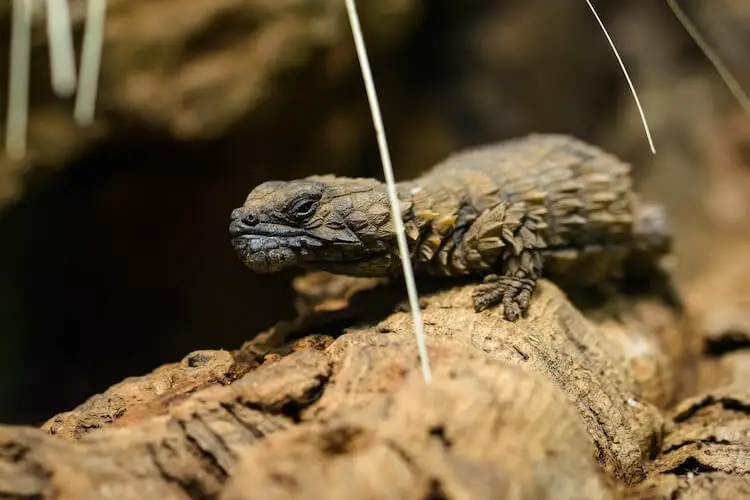
Is An Armadillo Lizard A Good Pet?
Armadillo Lizards are popular pets because of their spiny coats of armor that make them look like a dragon.
This reptile belongs to the Cordylidae family. A family of girdled lizards (i.e. spiny-tailed) from South Africa.
Armadillos are found in the western districts of South Africa.
Their range stretches 400 miles from the Orange River to the Piketberg Mountains and inland to Matjiesfontein – a semi-desert region of South Africa.
Armadillos have prominent spines that help to protect them from predators in the wild.
Their unique appearance makes them look like a tiny dragon.
When they see a predator, if they feel they need to protect themselves, they curl into a ball and bite their tails. Researchers noted this behavior bears a striking resemblance to a frightened mammalian armadillo. So they named this lizard after the Armadillo.
These lizards also have unique social behaviors too.
Unlike many independent lizards Armadillos prefer to live in groups. This even happens when there is enough shelter to house each lizard individually.
This social behavior has captivated herpetologists and researchers.
What We Like About The Armadillo Lizard
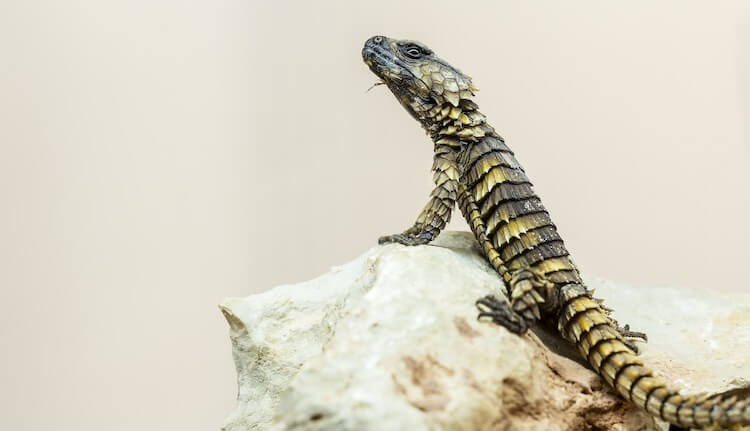
They make a great pet for many reasons:
Pros
- Very hardy and easy to care for.
- Unique dragon-like appearance.
- Armadillos prefer to live with others – so you can own more than one.
Cons
- They can become stressed with handling.
- Breeding in captivity can be difficult.
- Difficult to buy as they are illegal to export from South Africa.
Species Appearance
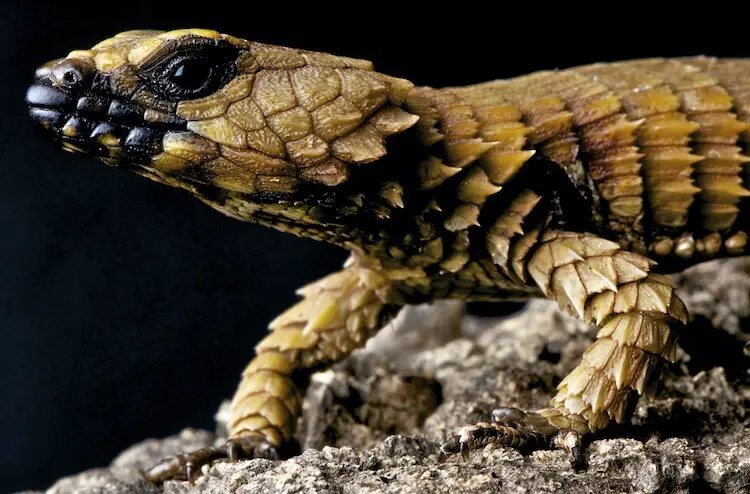
Armadillos are easily identified by their armor-like skin.
This girdled lizard has spiny armor-like skin all over their head, body, tail, and legs. These spikes are called osteoderms and are also found on other reptiles such as Sulcata Tortoises, alligators and crocodiles.
Their body and head are flat to give them the ability to squeeze between rocks.
Unlike other popular pet reptiles such as the Bearded Dragon, the Armadillo Lizard is not very colorful. They are generally light to dark brown.
Their underbellies are normally yellow with a black pattern.
Armadillo Lizard Size
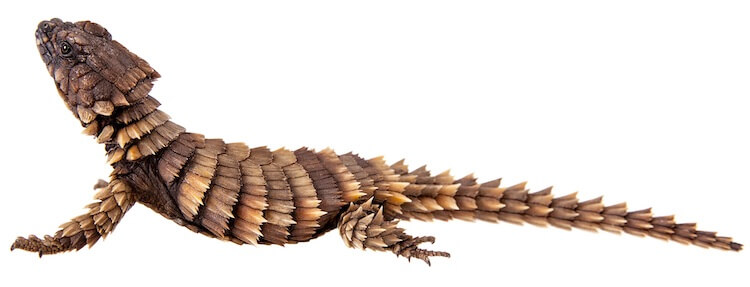
Adult Armadillos are very small and grow to just over four inches in length.
Several websites claimed this species is actually 15 – 17 inches long – this is incorrect.
Neonatal Armadillos are born around two inches in length. They are considered juveniles when they grow between 2.3 and 3.7 inches.
Males are normally slightly longer than females, but they are generally very close in size. This means length is not always an accurate indicator of their sex. Instead use the fact that Males have hemipenal bulges and broader heads as identifiers.
Typical Behavior
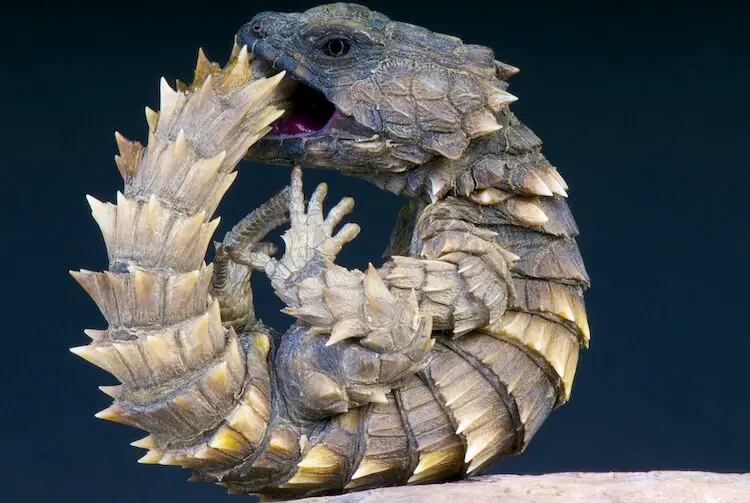
The Armadillo Lizard is named for its appearance when being defensive.
They grab their tail and roll into a ball (pictured above).
Armadillo Girdled Lizards spend most of their time basking in the sun or hiding between rocks. That is because they are heavily built and slow-moving.
Because of their heavily armored skin they cannot run away from predators.
In the wild they are nearly always found in groups of four to six lizards. Some have theorized that gathering in groups may offer some protection from predators.
Males can become territorial, especially during the mating season.
The mating season in South Africa begins in September and lasts for two months. They have very powerful jaws and have been known to bite off toes and draw blood.
When males wish to mate they pursue a female until courtship occurs. Unlike reptiles that lay eggs, females give birth to one live offspring. Very rarely do they have two live offspring.
They brumate during the winter. In captivity, many owners keep tank temperatures consistently high enough to prevent brumation.
Armadillo Lizard Care Sheet
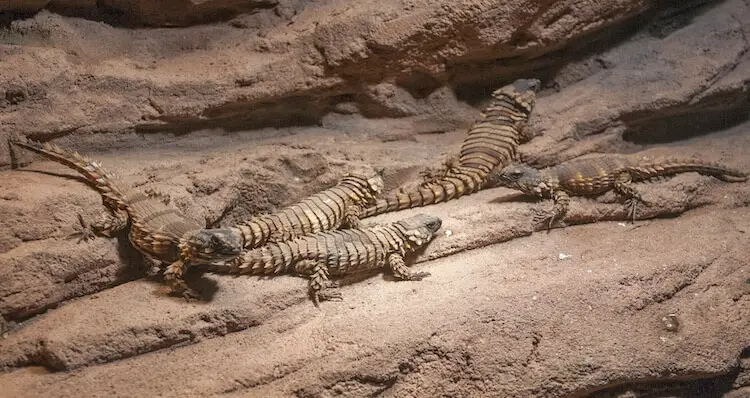
These lizards spend most of their time basking or lying under rocks.
They are not very active.
Despite their strong bite they rarely bite in captivity.
They are known to be very docile but can become stressed with handling.
Rather than scurry under rocks when they are scared, they tail-bite and roll into a ball (like a Ball Python). If this happens the best thing you can do is to give your lizard space and time to relax.
They may tolerate a few minutes of handling but it is best to handle them as little as possible.
What Do Armadillo Lizards Eat?
Armadillos are sit-and-wait predators that mostly eat termites. Termites are an extremely important part of their diet so they often forage at termite mounds.
These carnivores are slow-moving so prefer to sit-and-wait for any prey that is larger than a termite.
They will also eat crickets, spiders and millipedes in the wild.
When kept in captivity you should feed an Armadillo crickets. Crickets should be gut loaded and dusted with a calcium supplement. They can be wild-caught or ordered from a commercial pet store.
Feed a handful of crickets so that your lizard eats most if not all of them. Neonatal and juveniles should eat every day and adults three times a week.
Armadillos will eat plant matter but you should not feed leafy greens as it does not provide the right nutritional balance.
They can also eat:
- Superworms.
- Butterworms.
- Pinky mice.
Finally, they should always have access to fresh water.
A low flat dish of water is best. Avoid using a high-rimmed bowl because if they get caught in the water dish they can drown.
Armadillo Lizard Lifespan & Health
One reason this species is such a great pet is because they live long lives and recover well from illness.
These tiny dragons can live for 25 years in captivity.
They have relatively few health issues, but there are a couple illnesses owners should be aware of.
Girdled Lizards are occasionally prone to mouth infections.
One sign of a mouth infection is if your lizard is chasing its food but not biting at it. They may also have pus around the infection. The best thing to do is take your lizard to the vet for antibiotics. Armadillo Lizards are very hardy and usually recover from these infections quickly.
They are also prone to femoral pore infections. One sign of infection is swelling on the rear legs.
The best way to prevent these infections is to put rough rocks in the enclosure to allow your lizard to rub against them to clean their pores.
A common health problem with wild-caught Armadillos (despite them being illegal to export from South Africa) is parasites. A total lack of interest in food is a common symptom of parasites.
Signs They Are Healthy
- Basking frequently.
- Occasionally hiding under rocks.
- Eating lots of food.
Sickness Symptoms
- Excreting pus around the mouth area.
- Swelling in the rear legs.
- Uninterested in food or will not bite food.
Armadillo Lizard Enclosure

Armadillo Lizards live in rocky outcrops. This allows them to wedge themselves between crevices and bask.
Reptiles do best when their captive environment mimics their natural one.
This means their habitat should have high temperatures, low humidity and plenty of rocks.
There should be lots of flat rocks for your lizard to lie on top of and under. You can prop rocks an inch off the bottom of the enclosure using shale.
Cage & Set Up
- Tank Type: glass or plexiglass.
- Tank Size: 30-gallon.
- Lighting: fluorescent.
- Substrate: reptile carpet.
Several Armadillos can be housed together. They are usually social and will not fight. One or two can live comfortably in a 30-gallon tank.
The tank can be made from glass or plexiglass.
Armadillo Lizards like climbing on rocks but they are not very good at climbing on glass walls! If your tank’s walls are high enough you will not need a lid/top.
Fluorescent lighting is a good way to ensure that your lizard gets enough vitamin D.
Leave the lighting on for 12 hours a day to help your girdled lizard keep a natural circadian rhythm.
Most of the tank should be between 80℉ – 85℉ during the day and 60℉ – 70℉ at night. The best way to achieve this is with an under-the-tank heating pad.
They should have a basking area of 115℉ – 130℉ because they spend so much time basking on rocks in the wild.
Humidity in the tank should be kept between 45% – 55%.
In the wild Armadillo Girdled Lizards are used to a sandy environment. However, in captivity your lizard can accidentally ingest a sandy substrate. A reptile carpet or newspaper is better.
You should spot clean and change the water bowl daily. Thoroughly clean everything in the tank once a month.
Buyer’s Guide: Are Armadillo Girdled Lizards Illegal?
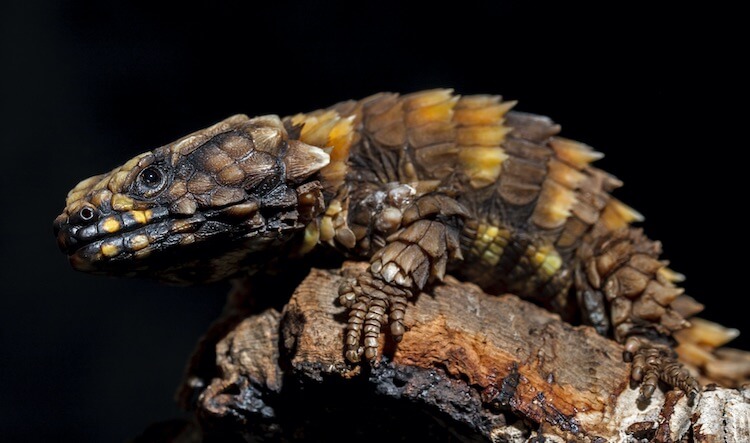
It is illegal to export a wild-caught Armadillo Lizard from South Africa.
They are easily captured from the wild because they are tame and slow-moving. Constant capturing of these creatures has led them to become a vulnerable species. It is now illegal to capture and export these lizards.
If you are serious then purchase a captive-bred from a private breeder.
How Much Does An Armadillo Lizard Cost?
The price of an Armadillo Lizard is between $1,000 – $2,000. This is because they are very rare and do not reproduce in great numbers like many other lizards.
Most species of reptiles can produce at least one clutch of several eggs a year. This species only give birth to one neonate each year.
Care and tank setup are no more expensive than the setup cost for most lizards. Thirty-gallon tanks are typically $200 , and under-the-tank heaters are ~ $20.
Their diet is also cheap as crickets normally cost $2 for packs of 50.
What Is It Like To Own Armadillo Lizard
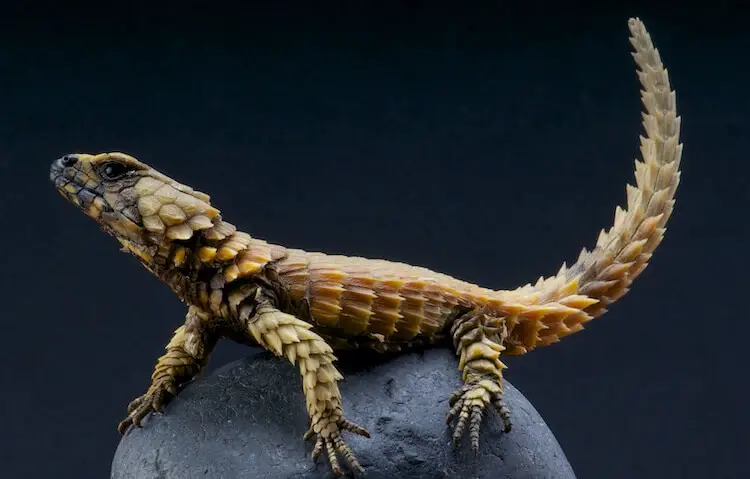
They are hardy and docile pets.
Before you bring your lizard(s) home you should already have their habitat setup.
After transferring your Armadillo to its new home give it a day or two to adjust before disturbing. When your lizard starts to display normal behaviors such as basking or hiding between rocks then introduce a regular feeding schedule.
A potential owner should expect an inactive lizard that spends most of the day under the basking lamp or hiding between rocks.
If they feel they need to protect themselves from you then they will curl into a ball and bite their tails.
Armadillo Lizards can get very stressed when handled.
Do not hold them aggressively as this is how a bird of prey would grab them.
This adjustment period may take several weeks. When done correctly your Armadillo will start to become more used to life in your home and display their unique personality.
Armadillo Lizard Facts
| Common Name | Armadillo Girdled Lizard |
|---|---|
| Scientific Name | Ouroborus cataphractus, Cordylus cataphractus |
| Price | ~$1,000 |
| Size | 3.7 – 4.1 inches |
| Lifespan | ~25 years |
| Diet | Crickets |
| Tank Size | 30-gallon |
| Humidity & Temperature | Daytime temperature: 80℉ – 85℉ Basking Spot: 115℉ – 130℉ Humidity: 45% – 55% |
| Popular Alternatives | Bearded Dragons, Crested Geckos, Leopard Geckos |
Summary
The Armadillo Lizard is named after the way it bites its tail to protect itself from predators. This is a behavior not seen in any other reptile species.
These lizards are very popular because of their spiny skin that makes them look like a dragon.
They are great pets for beginners because they are hardy and very easy to care for. However, this lizard is mostly found in experienced keepers’ homes because it is rare and expensive.
These tiny pet dragons make a great choice – if you can find one. If you struggle to find one there are alternatives such as Bearded Dragons and Leopard Geckos.
Let us know in the comments if you have ever seen one of these beautifully armoured lizards.



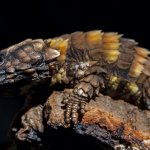


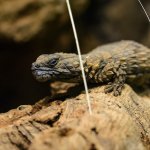

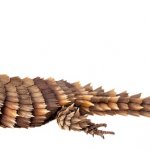
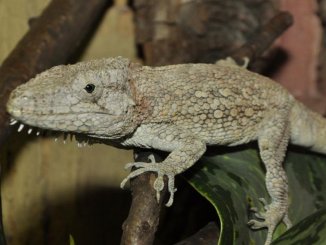
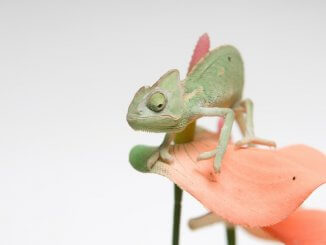
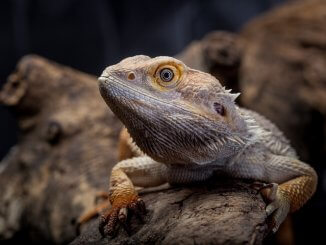
from what im reading they shouldnt even be sold individually. they like groups. and dont like being handled. so buying ONE and trying to compensate for it being the only one by handling it will not work. and they have ONE baby at a time…!!
I wish they were here